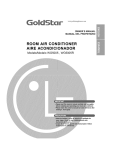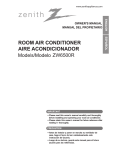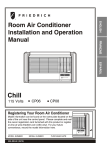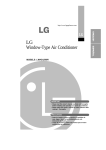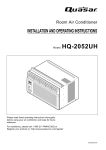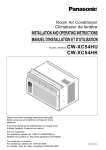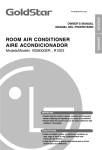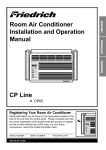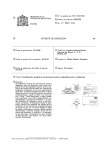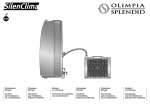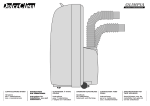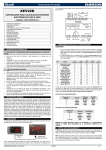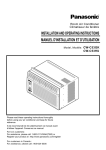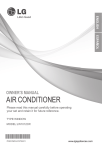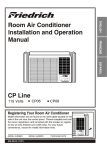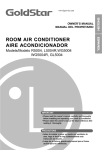Download LG LWHD8000R User's Manual
Transcript
Window-Type Air Conditioner Owner’s Manual TABLE OF CONTENTS Safety Precautions..........................3 FOR YOUR RECORDS Write the model and serial numbers here: Before Operation .............................7 Model # Serial # Introduction ....................................8 Symbols Used in this Manual ........8 Features ........................................8 Electrical Safety ..............................9 Temporary Use of an Adapter ........................................11 Temporary Use of an Extension Cord ............................11 Installation ....................................12 Window Requirements ................12 Size ...........................................12 Clearance .................................13 Preparation of Chassis ...............14 Unit Installation ............................15 Operating Instructions .................17 Remote Control Operations ........17 Remote Controller .......................18 Additional Features.......................19 Air Direction ..............................19 Vent Control ..............................19 Drain Pipe..................................20 Removal from Window...............20 Maintenance and Service ............21 Air Filter ....................................21 Cleaning the Air Conditioner .....21 How to Remove the Front Grille ................................22 Common Problems and Solutions.......................................23 Troubleshooting ............................24 2 Room Air Conditioner You can find the numbers on a label on the side of the product. Dealer's Name Date Purchased ■ Staple your receipt to this page in the event you need it to prove date of purchase or for warranty issues. READ THIS MANUAL Inside you will find many helpful hints on how to use and maintain your air conditioner properly. Just a little preventive care on your part can save you a great deal of time and money over the life of your air conditioner. You'll find many answers to common problems in the chart of troubleshooting tips. If you review our chart of Troubleshooting Tips first, you may not need to call for service at all. PRECAUTION • Contact an Authorized Service Center for repair or maintenance of this unit. Call 1-800-243-0000 to locate the nearest ASC. • This air conditioner is not intended for use by young children or invalids without supervision. • Young children should be supervised to ensure that they do not play with the air conditioner. • If the power cord requires replacement, have an Authorized Servicer install an exact replacement part. • Installation work must be performed in accordance with the National Electric Code by qualified and authorized personnel only. Safety Precautions Safety Precautions WARNING This symbol indicates the possibility of death or serious injury. CAUTION This symbol indicates the possibility of injury or damage to property only. ■ Meanings of symbols used in this manual are as shown below. Be sure not to do. Be sure to follow the instruction. WARNING ■ Installation Always install the expansion panel(s). • Improper assembly or installation may cause incorrect operation, including injury, fire, and Do not use the power cord near flammable gas or combustibles such as gasoline, benzene, thinner, etc. • It may cause explosion or fire. Do not place the power cord near a heater. • It may cause fire and electric shock. Do not disassemble or modify products. • It may cause electric shock and failure. Gasolin Owner’s Manual 3 ENGLISH To prevent injury to the user or other people and property damage, the following instructions must be followed. ■ Incorrect operation due to ignoring instructions will cause harm or damage. The seriousness is classified by the following indications. ■ Because of the weight of the product, it is recommended that you have a helper to assist in the installation. Safety Precautions ■ Operation Plug in the power plug properly. • Otherwise, it will cause electric shock or fire. Do not operate or stop the unit by inserting or pulling out the power plug. Do not damage or use an unspecified power cord. • It will cause electric shock or fire. • It will cause electric shock or fire. ON ON Do not modify power cord length. • It will cause electric shock or fire. Unplug the unit if strange sounds, odors, or smoke come from it. • Otherwise it will cause fire and electric shock accident. 4 Room Air Conditioner Use the air conditioner on a single outlet circuit. (See page 7.) Do not share the outlet with other appliances. • It will cause electric shock or fire. Do not use the socket if it is loose or damaged. • It may cause fire and electric shock. Always plug into a grounded outlet. • No grounding may cause electric shock. Do not operate with wet hands or in damp environment. • It may cause electric shock. Safety Precautions Close all doors, windows and other outside openings to the room. • It may cause explosion, fire, and burn. If water enters the product, turn off the power switch of the main body of appliance. Contact service center after taking the powerplug out from the socket. • It will cause electric shock or failure of machine. Do not clean the air conditioner with water. • Water may enter the unit and degrade the insulation. It may cause an electric shock. CAUTION ■ Installation Never touch the metal parts of the unit when removing the filter. • They are sharp and may cause injury. Do not block the inlet or outlet. • It may cause failure of appliance or performance deteriorate. Ensure that the outer case is not damaged by age or wear. • If the outer case is damaged, it must be repaired or replaced immediately. Leaving it damaged could result in the air conditioner falling out of the window, creating a safety hazard. Owner’s Manual 5 ENGLISH • The air conditioner must be operated in a enclosed area to be most effective. Ventilate before operating air conditioner when gas goes out. Safety Precautions ■ Operation Be cautious not to touch the sharp edges when installing. • It may cause injury. Sharp edges Unplug the air conditioner before cleaning it. Unplug the air conditioner if it will not be used for a long period. • It may cause electric shock and damage. Do not put a pet or house plant where it will be exposed to direct air flow. • Since the fan rotates at high • This could injury the pet or speed during operation, it may plant. cause injury. Always insert the filter securely. Clean it every two weeks. • Operation without filters will cause failure. Use a soft cloth to clean. Do not use wax, thinner, or a strong detergent. • The appearance of the air conditioner may deteriorate, change color, or develop surface flaws. x Wa Thinner 6 Room Air Conditioner • It will waste power consumption in vain and it may cause accident. Do not use this appliance for special purposes such as pets, foods, precision machinery, or objects of art. • It is an air conditioner, not a precision refrigeration system. Do not drink water drained from air conditioner. Do not direct airflow at room occupants only. • It is not sanitary and could cause illness or personal injury hazard. Before Operation Before Operation 1. 2. 3. 4. 5. Plug in the power cord properly. Use a dedicated circuit. Overloading the line could create a fire hazard. Do not use an extension cord. See page 11 for more details. Do not start/stop operation by plugging/unplugging the power cord. If the power cord is damaged and requires replacement, have an Authorized Servicer install an exact replacement part. Usage 1. Being exposed to direct airflow for an extended period of time could be hazardous to your health. Do not expose occupants, pets, or plants to direct airflow for extended periods of time. 2. Due to the possibility of oxygen deficiency, ventilate the room when used together with stoves or other heating devices. 3. Do not use this air conditioner for non-specified special purposes (e.g. preserving precision devices, food, pets, plants, and art objects). Such usage could damage the items. 4. The air conditioner is a consumer comfort appliance, not a precision climate control system. Cleaning and Maintenance 1. Do not touch the metal parts of the unit when removing the filter. Injuries can occur when handling sharp metal edges. 2. Do not use water to clean inside the air conditioner. Exposure to water can destroy the insulation, leading to possible electric shock. 3. When cleaning the unit, first make sure that the power and breaker are turned off. The fan rotates at a very high speed during operation. There is a possibility of injury if the unit’s power is accidentally triggered on while cleaning inner parts of the unit. Service For repair and maintenance, contact an Authorized Service Center. See the warranty page for details or call (800) 243-0000. Have your model number and serial number available. They should be written on page 2 of this manual. Owner’s Manual 7 ENGLISH Preparing for Operation Introduction Introduction Symbols Used in this Manual This symbol alerts you to the risk of electric shock. This symbol alerts you to hazards that could cause harm to the air conditioner. Tip! This symbol indicates special notes. Features WARNING: This appliance should be installed in accordance with the National Electric Code. Upper Guide Cabinet Horizontal Air Deflector (Horizontal Louver) Vertical Air Deflector (Vertical Louver) Air Discharge Front Grille Air Filter Air Intake (Inlet Grille) Brace Evaporator Control Board Compressor Condenser Base Pan Remote Controller 8 Room Air Conditioner Power Cord Electrical Safety Electrical Safety ENGLISH Electrical Data 115V~ Use Wall Receptacle Standard 125V, 3-wire grounding receptacle rated 15A, 125V AC 230V~ Power cord may include a current interrupter device. A test and reset button is provided on the plug case. The device should be tested on a periodic basis by first pressing the TEST button and then the RESET button. If the TEST button does not trip or if the RESET button will not stay engaged, discontinue use of the air conditioner and contact a qualified service technician. Use of extension cords Power Supply Use 15 AMP. time delay fuse or 15 AMP. circuit breaker. Because of potential safety hazards, we strongly discourage the use of an extension cord. However, if you wish to use an extension cord, use a CSA certified/UL-listed 3-wire (grounding) extension cord, rated 15A, 125V. All wiring should be made in accordance with local electrical codes and regulations. Standard 250V, 3-wire grounding receptacle rated 15A, 250V AC Standard 250V, 3-wire grounding receptacle rated 20A, 250V AC NOTICE Use 20 AMP. time delay fuse or 20 AMP. circuit breaker. Aluminum house wiring may pose special problems. Consult a qualified electrician. ELECTRICAL SAFETY IMPORTANT GROUNDING INSTRUCTIONS Air conditioner has a three-prong grounding plug on its power supply cord, which must be plugged into properly grounded three-prong wall receptacle for your protection against possible shock hazard. 230, 208, and 230/208 VOLT UNITS These units are equipped with a three-prong grounding plug on the power supply cord, which must be plugged into a matching properly grounded three-prong wall receptacle for your protection against possible shock hazard. If such an outlet is not present, one must be installed by a qualified electrician in accordance with the National Electrical Code and local codes and ordinances. NOTICE DO NOT USE AN EXTENSION CORD on 230, 208, and 230/208 Volt units. , 9 Electrical Safety Electrical Safety WARNING: This appliance must be properly grounded. The power cord of this appliance is equipped with a three-prong grounding plug. To minimize the risk of electric shock, use the plug with a standard three-slot grounding wall power outlet. If the power outlet does not include a grounding slot, have a qualified electrician replace the outlet before you use the room air conditioner. WARNING: Changing the outlet without making the appropriate wiring changes will create an unsafe condition that could result in fire or electrical shock. Refer all such work to a licensed and qualified electrician. Preferred method Ensure proper ground exists before use WARNING: Do not cut or remove the grounding prong from the power plug. WARNING: Attaching the adapter ground terminal to the wall receptacle cover screw does not ground the appliance unless the cover screw is metal and not insulated, and the wall receptacle is grounded through the house wiring. WARNING: If you have any doubt whether the air conditioner is properly grounded, have the wall receptacle and circuit checked by a qualified electrician. 10 Room Air Conditioner Electrical Safety Temporary Use of an Adapter To disconnect the power cord from the adapter, use one hand on each to avoid damaging the ground terminal. Avoid frequently unplugging the power cord as this can lead to eventual ground terminal damage. Temporary method Adapter Plug Metal Screw Receptacle Cover WARNING: Never use the appliance with a broken adapter. Temporary Use of an Extension Cord We strongly discourage the use of an extension cord due to potential safety hazards. For temporary situations, use only CSA certified and UL listed 3-wire grounded extension cords, rated 15 A, 125 V. Owner’s Manual 11 ENGLISH We strongly discourage the use of an adapter due to potential safety hazards. For temporary connections, use only a UL-listed adapter, available from most local hardware stores. Ensure that the large slot in the adapter is aligned with the large slot in the receptacle for a proper polarity connection. Installation Installation Type B: 5 EA (Wood Screw) Type C: 1 EA (Drain Joint Pipe) Type D: 3 EA (L Bracket) 16mm 10mm Type A: 11 EA (Short Screw) Type E: 1 EA (Seal Strip) Type F: 1 EA (Sash Seal) (Adhesive backed) (Not adhesive backed) Type G: 2 EA (Guide Panel) Type H: 1 EA (Support Bracket) Have the following tools available for installation: * Screwdriver (Slotted and Phillips) * Knife * Pencil * Ruler * Hammer * Level Window Requirements Size This room air conditioner is designed for installation in standard double-hung windows with actual opening widths from 22" to 36". The upper and lower window sash must open sufficiently to allow a clear vertical opening of 13" from the bottom of the upper sash to the window stool. 22" to 36" 13" min WARNING: This product is a WINDOW AIR CONDITIONER. As such, a standard single-hung or double-hung window is required for proper installation. Non-window installations, including using sleeves, holes in walls, and other installations are not recommended. 12 Room Air Conditioner Installation Clearance 1. If a storm window presents interference, fasten a 2" wide wood strip to the inner window sill across the full width of the sill. The wood strip should be thick enough to raise the height of the window sill so that the unit can be installed without interference by the storm window frame. 2. See Figure. B. The top of the wood strip should be approximately 3/4" higher than the storm window frame (Storm Window Frame) or wood strip (Outdoors) to help condensation to drain properly to the outside. 3. Install a second wood strip (approximately 6" long by 11/2" wide and same thickness as first strip) in the center of the sill flush against the back off the inner sill. This will raise the L bracket as shown Figure. B. 4. If the distance between Storm Window Frame and Wood Strip Mounted on Top of Inner Sill is more than 1", two of wood strips are not necessary. Wood Strip Mounted on Top of Inner Sill Inner Sill 1" Max. 3 /4" Clearance Storm Window Frame Inner Sill Wood Strip for L Bracket Outer Sill Outer Sill Indoors Outdoors Indoors Figure. A Outdoors Figure. B Owner’s Manual 13 ENGLISH Proper clearance enhances the cooling efficiency of the unit and prevents heat radiation of the condenser. Installation Preparation of Chassis 1. Insert the guide panels into the guides of the air conditioner. Fasten the curtains to the unit with screws (Type A). Type A Tip! : Use a long screwdriver and installing the screws will be easier. Type A 2. Cut the adhesive-backed seal strip (Type E) to the window width. Remove the backing from the seal strip and attach the seal strip to the underside of the bottom window. 3. Locating unit in window Open the window and mark center line on the center of the inner sill. Seal Strip (Type E) Center Line Inner Sill Room Side 4. Attach L bracket 4-1. Install the L brackets behind the inner window sill, with short side of bracket as shown. Use the 2 screws (Type A) provided. 4-2. The bracket helps to hold unit securely in place. Be sure to place bracket edge flush against back of inner sill. 14 Room Air Conditioner Inner Sill Type A Outer Sill Inside Center Line 8" 8" Outside L Bracket Installation Unit Installation 1. Install the air conditioner in the window 1-1. Carefully lift the air conditioner and slide it into the open window. Make sure the bottom guide of the air conditioner drops into the notches of the L bracket. C ool F F an Dry Tip! : When the air conditioner drops into the L bracket, the air conditioner will be centered in window opening. 1-2. While steadying the air conditioner, carefully bring the window sash down behind the upper guide of the air conditioner. When the air conditioner is properly installed, it should tilt slightly down at the back. If it is set correctly in the window, it will hang lower in the back automatically. If it does not, there is a problem with the installation. F 1 L OW F 2 ME D F 3 HIG H E nergy S aver T imer T E MP C enter Line Window Frame Upper Guide Seal About 1/4" Bottom Guide L Bracket 2. Secure the guide panels Extend the guide panels (Type G) to fill the window opening using 4 screws (Type B) to secure them. 3. Install the sash seal and sash lock 3-1. Cut the sash seal (Type F) to the window width. Stuff the sash seal between the glass and the window to prevent air and insects from getting into the room. 3-2. Fasten the L bracket using a screw (Type A). 3-3. Remove the screws that secure the cabinet and base pan in the right side. L Bracket Type A Type B Sash Seal (Type F) Owner’s Manual 15 ENGLISH Caution: During the following step, hold unit firmly until window sash is lowered to top channel behind side panel frames. Personal injury or property damage may result if unit falls from window. Installation 3-4. Fasten the support bracket (Type H) using a screw removed from the air conditioner cabinet. Attach the support bracket (Type H) to the inner window sill with a screw (Type B). Type B Support Bracket (Type H) 4. Window installation of room air conditioner is now completed. See ELECTRICAL DATA for attaching power cord to electrical outlet. 16 Room Air Conditioner Operating Instructions Remote Controller CAUTION: The Remote Controller will not function properly if strong light strikes the sensor window of the air conditioner or if there are obstacles between the Remote Controller and the air conditioner. Power Operation starts when this button is pressed and stops when you press the button again. Temperature Control The thermostat monitors room temperature to maintain the desired temperature. The thermostat can be set between 60 F~86 F (16 C~30 C). The unit takes an average of 30 minutes to adjust the room temperature by 1 F. Power Temp Fan Speed Fan Speed For increased power while cooling, select a higher fan speed. 3 steps: High Low Med Timer Mode Auto Swing On/Off Timer The timer can be set to start and stop the unit in hourly increments (up to 12 hours). Operation Mode Selector Select cooling mode to cool the room. Select energy saver mode for energy saving operation. Select fan mode for basic ventilating fan operation. Select dry mode for dry operation. How to Insert Batteries 1. Remove the cover from the back of the remote controller 2. Insert two batteries. Be sure of the polarity when installing the batteries. Be sure that both batteries are new. 3. Re-attach the cover. 18 Room Air Conditioner Do not use rechargeable batteries. Such batteries differ from standard dry cells in shape, dimensions, and performance. Remove the batteries from the remote controller if the air conditioner is not going to be used for an extended length of time. Operating Instructions Additional Features ENGLISH Air Direction Airflow can be adjusted by changing the direction of the air conditioner's louvers. This can also increase the cooling efficiency of the air conditioner. Adjusting Horizontal Air Flow Direction Adjusting the vertical louvers left and right will change horizontal airflow. Adjusting Vertical Air Flow Direction Adjusting horizontal air flow Adjusting the horizontal vane up and down will change vertical airflow. The vane can be adjusted by nudging the back or up and down of the vane. Recommended orientation of louvers Adjust louvers to face upwards when cooling to maximize cooling efficiency. Adjusting vertical air flow Vent Control For maximum cooling efficiency, CLOSE the vent. This will allow internal air circulation. OPEN the vent to discharge stale air. CLOSE VENT OPEN Owner ,s Manual 19 Operating Instructions Ad Additional Features Drain Pipe In humid weather, excess water may cause the Base Pan to overflow. To drain the water, remove the Drain Cap and secure the Drain Pipe to the rear hole of the Base Pan. Press the drain pipe into the hole by pushing down and away from the fins to avoid injury. This air conditioner is equipped with a slinger fan. (See drawing, below.) The fan has an outer ring that runs in the water that collects in the base pan if it gets deep. That condensate is then picked up by the fan and expelled through the condenser, making the air conditioner more efficient. Drain Pipe Drain Cap Ring CAUTION: Be careful when inserting the drain pipe. Push away from the sharp fin area to avoid slipping injuring yourself. Removal From Window Turn the air conditioner off, disconnect the power cord, remove the L bracket, the screws and Support Bracket installed through the top and bottom of the guide panels, and save for reinstallation later. Close the guide panels. Keeping a firm grip on the air conditioner, raise the sash, and carefully tilt the air conditioner backward, draining any condensate. Lift the air conditioner from the window and remove the sash seal from between the windows. Be sure to drain ALL condensate from the air conditioner. If you don't, it could run out while you carry the unit, making a mess and creating a slipping hazard. This simple step will save you much cleaning and make a safer work environment. 20 Room Air Conditioner Maintenance and Service Maintenance and Service Check the air filter at least twice a month to see if cleaning is necessary. Trapped particles in the filter can build up and block the airflow, reducing cooling capacity and causing an accumulation of frost on the evaporator. To clean the air filter: Do not force open or open to far. 1. Pull the inlet grille forward. 2. Remove the air filter from the front grille by pulling the air filter up slightly. 3. Wash the filter using lukewarm water below 40 C (104 F). 4. Gently shake the excess water from the filter and replace. Cleaning The Air Conditioner The front grille and Inlet grille may be wiped with a cloth dampened in a mild detergent solution. The cabinet may be washed with mild soap or detergent and lukewarm water, then polished with Liquid Wax for Appliances. Cool F1 LOW F2 MED F3 HIGH Energy Saver F Fan Dry Timer TEMP To ensure continued peak efficiency, the condenser coils (outside of unit) should be checked periodically and cleaned if clogged with soot or dirt from the atmosphere. Owner ,s Manual 21 ENGLISH Air Filter Maintenance and Service How to Remove the Front Grille 1. Pull the inlet grille forward 2. Remove the screw securing the Front Grille. 3. Push the grille up from the bottom and pull the top of the grille away from the case as the top tabs lift out of their slots. 22 Room Air Conditioner Cool F1 LOW F2 MED F3 HIGH Energy Saver Fan Dry Timer TEMP F Maintenance and Service Common Problems and Solutions If you have problems with your air conditioner, read the following information and try to solve the problem. If you cannot find a solution, turn off the air conditioner and contact your dealer. Air conditioner does not operate 1. Ensure that the air conditioner is plugged into a proper outlet. 2. Check the fuse or circuit breaker. 3. Check whether the voltage is unusually high or low. Air does not feel cold enough on the cooling setting 1. Ensure that the temperature settings are correct. 2. Check to see if the air filter is clogged with dust. If so, clean the filter. 3. Ensure that the air flow from the outside is not obstructed and that there is a clearance of over 20" between the back of the air conditioner and the wall or fence behind it. 4. Close all doors and windows and check for any source of heat in the room. Before calling for service, please review the following list of common problems and solutions. The air conditioner is operating normally when: • You hear a pinging noise. This is caused by water being picked up by the fan on rainy days or in highly humid conditions. This feature is designed to help remove moisture in the air and improve cooling efficiency. See the section on Slinger Fan, page 20. • You hear the thermostat click. This is caused by the compressor cycle starting and stopping. • You see water dripping from the rear of the unit. Water may be collected in the base pan in highly humid conditions or on rainy days. This water overflows and drips from the rear of the unit. • You hear the fan running while the compressor is silent. This is a normal operational feature. Owner’s Manual 23 ENGLISH Before Calling for Service Memo ENGLISH Owner’s Manual 25 Memo 26 Room Air Conditioner Precauciones de Seguridad Precauciones de Seguridad Para prevenir tanto lesiones al usuario u otras personas como daños materiales, es preciso seguir estas instrucciones. ■ La incorrecta operación del aparato como consecuencia de ignorar las instrucciones provocará daños o lesiones. ■ A cause del peso pesado del producto, se recomienda que usted tenga a un ayudante a participa en la instalación. ADVERTENCIA Este símbolo indica la posibilidad de lesiones mortales o graves. PRECAUCION Este símbolo indica la posibilidad de lesiones o daños materi-ales. ■ El significado de los símbolos utilizados en este manual se indica a continuación. Asegúrese de no hacerlo. Asegúrese de seguir las instrucciones. ADVERTENCIA ■ Instalación Instale siempre el (los) panel(es) de expansion. • Un montaje o instalación defectuoso puede provocar un funcionamiento incorrecto, incluyendo riesgos de lesiones, incendios o No use el cable de corriente cerca de gas inflamable o combustibles tales como gasolina, benzina, solvente, etc. • Puede causar explosión o incendio. Gasolin 28 Aire Acondicionador No coloque el cable eléctrico cerca de un calefactor. • Puede causar incendio y descarga eléctrica. No desarme o modifique los productos. • Puede causar descarga eléctrica y fallos. Precauciones de Seguridad ■ Funcionamiento Enchufe la corriente adecuadamente. • De otro modo, causará descarga eléctrica o incendio. No haga funcionar o detenga la unidad insertando o tirando del enchufe. No dañe ni use un cable no especificado. • Causará descarga eléctrica o incendio. • Causará descarga eléctrica o incendio. ON ESPAÑOL No modifique la longitud del cable de corriente eléctrica. Use el aparato de aire acondicionado en un solo circuito. (Consulte la página 30). No comparta el circuito con otros electrodomésticos. • Causará descarga eléctrica o incendio. • Causará descarga eléctrica o incendio. Desenchufe la unidad si se producen sonidos u olores extraños en la unidad. No use el tomacorriente si está suelto o dañado. • En caso que no, puede causar incendio y accidente de corto circuito. • Puede causar incendio y accidente eléctrico. Siempre enchufe las piezas eléctricas en una salida conectada a masa. • Si no hay conexión a masa, se puede producir una descarga eléctrica. No haga funcionar la unidad con las manos húmedas o en un ambiente húmedo. • Puede causar descarga eléctrica. Manual del Propietario 29 Precauciones de Seguridad Cierre todas las puertas, ventanas y otras aberturas de la sala. • El aparato de aire acondicionado debe operarse en un área cerrada para ser más efectivo. Si entra agua a la unidad, gire el interruptor principal del artefacto. Tome contacto con el centro de servicio después de desconectar el enchufe del tomacorriente. • Causará descarga eléctrica o incendio. Ventile antes de hacer funcionar el acondicionador de aire cuando sale el gas. • Puede causar explosión, incendio, quemaduras. No limpie la unidad de aire acondicionado con agua. • Puede entrar agua en la unidad y disminuir la aislación. Puede causar una descarga eléctrica. PRECAUCION ■ Instalación Nunca toque las piezas de metal de la unidad cuando quite el filtro. • Son filosas y pueden causar lesiones. 30 Aire Acondicionador No bloquee la entrada o la salida de aire. Asegúrese de que la caja externa no está dañada por los anõs o desgaste. • Puede provocar el fallo de un • Si la carcasa exterior está dañada, debe electrodoméstico o deterioración repararse o recambiarse de su rendimiento. inmediatamente. Dejarla podría provocar que el aparato de acondicionado se caiga de la ventana, con el consiguiente peligro de lesiones. No ponga un animal domestico una planta de la casa en donde sera expuesto al flujo de aire directo Previo al Funcionamiento Antes de poner en marcha Preparar para el funcionamiento 1. Coloque el enchufe correctamente. 2. Use un único circuito para este aparato. Recargar el circuito podría provocar un riesgo de incendios. 3. No utilice un alargador. Consulte la página 36 para más detalles. 4. No arranque/detenga el funcionamiento enchufando/desenchufando el cable de corriente eléctrica. 5. Si el alargador está dañado y ha de ser recambiado, solicite a un técnico autorizado que instale un recambio exacto. Uso 1. Estar expuesto al flujo directo de aire por un período largo de tiempo puede constituir un riesgo para su salud. No exponga a las personas, mascotas o plantas al flujo directo por períodos largos de tiempo. 2. Debido a la posibilidad de falta de oxígeno, ventile la habitación cuando se use al mismo tiempo que estufas u otros dispositivos de calefacción. 3. No use este acondicionador de aire para propósitos determinados no especificados (por ej.: preservar dispositivos de precisión, alimentos, cachorros, plantas y objetos de arte). Tales usos puede dañar los elementos. 4. El aparato de aire acondicionado es un aparato diseñado para el confort del consumidor. No es un sistema aclimatizador. Limpieza y mantenimiento 1. No toque las partes de metal de la unidad cuando quite el filtro. Puede lastimarse cuando manipule bordes filosos de metal. 2. No use agua para limpiar adentro del acondicionador. La exposición al agua puede destruir la aislación y esto a su vez provocar una descarga eléctrica. 3. Cuando limpie la unidad, asegúrese que la corriente y el interruptor estén desconectados. El ventilador gira a muy alta velocidad cuando está funcionando. Existe la posibilidad de lesionarse si la energía se conecta accidentalmente cuando esté limpiando las piezas internas de la unidad. Servicio Para reparaciones y mantenimiento, póngase en contacto con un centro de servicio autorizado. Consulte la página de garantía o llame al número (800) 2430000. Tenga su númeor d emodelo y número de serie a mano. Los encontrará en la página 25 de este manual. 32 Aire Acondicionador Introducción Introducción Símbolos Utilizados en Este Manual Este símbolo lo advierte de un peligro de accidente por corriente eléctrica. CONSEJO Este símbolo significa condicciones especiales. Características ADVERTENCIA : Este aparato debería instalarse de acuerdo con las normas del Código Eléctrico Nacional. Guía Superior Deflector Vertical de Aire Deflector Horizontal de Aire Gavinete Salida de Aire Rejilla Frontal Filtro de Aire Toma de Aire (Recolector de Aire) Abrazadera Evaporador Panel de Control Compresor Condensador Bandeja de Base Control Remoto Cable eléctrica Manual del Propietario 33 ESPAÑOL Este símbolo lo adiverte de un peligro que pueda causar un daño del ventliador. Seguraida Electrica Seguraidad Electrica USO DE CORDONES DE EXTENSION Debido al potencial de peligro a su seguridad bajo ciertas circunstancias recomendamos encaredidamente no utiliar cordones de extension. Sin embargo, si usted decide usar un cordon de extension, es absolutamente necesario que este sea un cordon listado bajo UL de tres espigas con conexion a tierra calificado 15A, 125V. CONSEJO El cableado domestico de aluminio podria ocasionar problemas especiales. Consulte a un electricista calificado. 34 Aire Acondicionador Seguridad Eléctrica Seguridad Eléctrica Este equipo debe estar puesto a tierra debidamente. Cambiar la toma sin realizar los cambios de cableado apropiados creará un estado eléctrico inseguro que podría resultar en un incendio o descarga eléctrica. Para todo este tipo de trabajos, consulte siempre con un electricista cualificado. Método preferido Asegúrese que existe debida neutralización antes de utilizar el aparato. No corte ni quite el borne de tierra de la clavija de alimentación El acoplamiento del borne de tierra del adaptador con el tornillo de la cubierta del enchufe de pared no pondrá el equipo a tierra, si el tornillo de la cubierta no es de metal y está aislado y el enchufe de pared no está puesto a tierra a través de la red de la casa. En el caso de cualquier duda respecto a la correcta puesta a tierra del ventilador, haga revisar el enchufe de pared y el circuito por un electricista profesional. Manual del Propietario 35 ESPAÑOL El cable de alimentación está equipado de una toma de tierra con tres pins. Para minimizar el peligro de una lesión por corriente eléctrica, utilice una toma con enchufe de tierra estándar con tres contactos. Si el enchufe de pared no contiene un borne de tierra, antes de usar el ventilador haga cambiar el enchufe por un electricista. Seguridad Eléctrica Uso Transitorio de un Adaptador Debido a eventuales peligros de seguridad no recomendamos en absoluto el uso de un adaptador. Sólo para una conexión transitoria se puede usar el adaptador clasificado como UL que está a disposición en la mayoría de las tiendas de productos eléctricos. Atienda que e orificio grande en el adaptador corresponda al orificio grande en el enchufe para lograr la conexión con la polaridad correcta. Desconectando el cable de alimentación del adaptador utilice una mano para sendas partes para evitar un daño del borne de tierra. Evite una desconexión frecuente del cable de alimentación, pues puede causar un eventual daño del borne de tierra. Método temporal Adaptador Tornillo de Metal Cubierta del Interruptor Nunca utilice el equipo con un adaptador dañado. Uso Temporal de un Cable Alargador Debido a un eventual peligro no recomendamos en absoluto el uso de un cable alargador. En situaciones excepcionales utilice sólo alargadores certificados con puesta a tierra CSA clasificados como UL con tres conductores de valores 15 A, 125 V. 36 Aire Acondicionador Instalación Instalación Tipo B: 5 (Tornillo Mediano) Tipo D: 3 (El Paréntesis L) Tipo C:1 (Tube de Drenaje) 16mm 10mm Tipo A: 11 (Tornillo corto) Tipo F: 1 (Banda del Marco) (Adhesivo posterior) (No adhesivo posterior) Tipo G: 2 (Panel Guía) Tipo H: 1 (Sostenga Paréntesis) Para la instalación debería tener a disposición los instrumentos siguientes: * Destornillador (Estrella y Phillips) * Regla * Cucjillo * Martillo * Lápiz Nivel Requerimientos de Ventana Tamaño Este ventilador de casa está construido para ventanas estándar de dos alas con la extensión real de apertura de 22" a 36". El ala superior y el inferior de la ventana deben abrirse lo suficiente para producir un orificio vertical de 13" desde el ala superior hasta el antepecho. 22" a 36" Min. 13" ADVERTENCIA : Este producto es un aparato de AIRE ACONDICIONADO PARA INSTALACIÓN EN VENTANAS. Como tal, se necesita una ventana de un cuelgue o de doble cuelgue para una instalación adecuada. No se recomiendan instalaciones en lugares que no sean ventanas, utilizando casquillos, orificios en las paredes ni cualquier otro tipo. Manual del Propietario 37 ESPAÑOL Tipo E: 1 (Banda Adhesiva) Instalación z El suficiente espacio libre aumenta la eficiencia de refrigeración de la unidad e impide la irradiación del calor del condensador. 1. Si la sobre-ventana estorba colóquese una tira de madera de 2 pulg de ancho a lo largo del descanso de la ventana por la parte que de internamente al cuarto, y en toda su extensión. La tira de madera debe ser lo suficientemente gruesa para elevar el descanso de la ventana, de tal manera que la unidad de aire acondicionado pueda ser intalada sin interferencia del marco de la sobreventana (storm window). 2. Ver Figura. B. La parte superior de la tira de madera debe estar aproximadamente a 3/4 de pulg más alta que el marco de la sobre ventana, (storm window) para ayudar a que el agua de condensación de la unidad fluya hacia afuera. 3. Instale una segunda tira de madera (aproximadamente 6 pulg. de largo, 11/2 pulg de ancho y mismo espesor que la primeratira de madera) en el centro del descanso exterior, póngala contra la parte posterior del descanso interior. Esto elevará la ménsula L como en la Figura. B. 4. Si la distancia entre "Franja de Madera Montada Sobre la Parte superior del Descanso Interior" y "Tira de Madera Para la Mensula L y Mensula de Franja de Madera Montada Sobre la Parte superior del Descanso Interior 1" Max. Antepecho Interior 3/4-Pulg de Separacion Ventana de Hoja Double Antepecho Antepecho Interior Tira de Madera para la Mensula L y Mensula de Antepecho Antepecho Interior Exterior Interior Figura. A 38 Aire Acondicionador Exterior Figura. B Instalación Preparación de la Carcasa 1. Introduzca los paneles en los guías del aire acondicionado. Las cortinas atorníllelas con los tornillos (Tipo A). Tipo A CONSEJO Use un atornillador largo. Así le será más fácil instalar los tornillos. 2. Corte la banda adhesiva (Tipo E) y colóquela del ancho de la ventana. Remueva el plástico de la banda adhesiva y colóquela en la parte superior de el marco inferior de la ventana. 3. Colocando la unidad en la ventana Abra la ventana y marque LINEA en el centro esta. ESPAÑOL Tipo A Banda Adhesiva (Tipo E) Linea del Centro Antepecho Interior Taburete 4. Coloque el Ménsula en L 4-1. Instale los soportes L detrás de alféizar interno de la ventana, con el lado corto del soporte como está ilustrado. Utilice 2 tornillos (Tipo A) proveidos. 4-2. La ménsula ayuda a que la unidad se encuentre firme. Asegúrese de poner la ménsula en L contra la parte posterior del descanso interior. Descanso Exterior Descanso Interior Tipo A Interior Linea del Centro 8" 8" Exterior Ménsula en L Manual del Propietario 39 Instalación Instalación de la Unidad Precautión: En las siguientes instrucciones, sostenga la unidad firmemente hasta que la parte corrediza de la ventana descanse sobre la parte superior del canal y por detrás del marco de los paneles corredizos. Puede haber lesiones o daños si la unidad se cae de la ventana. 1. Instale el Aire Acondicionado a la Ventana 1-1. Cuidadosamente levante el aire acondicionado y colóquelo en el hoyo de la ventana. Asegúrese de que la guía inferior del aire acondicionado caiga en lugar correcto del ménsula en L. C ool F 1 L OW F 2 ME D F 3 HIG H E nergy S aver F F an Dry T imer T E MP Linea del C entro Cuando el aire acondicionado sea fijado en el support en L, el aire acondicionado será centrado como pueden observar. CONSEJO 1-2. Mientras mantiene el aire acondicionado en posición, cuidadosamente baje el borde de la ventana superior hasta la guía superior del aire acondicionado. Una vez instalado debidamente el aparato de aire acondicionado, debería inclinarse ligeramente hacia abajo en su parte posterior. Si está mal puesto en la ventana, colgará más abajo por la parte posterior automáticamente. Si no lo hace, hay una problema con la instalación. 2. Asegure los Paneles Extienda los paneles para rellenar los orificios de la ventana usando los 4 tornillos (Tipo B). 3. Instale la Banda del Marco 3-1. Corte la banda del marco del mismo ancho de la ventana. Coloque la banda del marco entre el vidrio y la ventana para prevenir la penetración al cuarto de insectos y aire. 3-2. Atornille la cerradura del marco usando un tornillo Tipo A. 3-3. Quite los tornillos que aseguran el gabinete y cacerola despreciable en el lado correcto. 40 Aire Acondicionador Borde de la Ventana Superior Guía Superior Banda Aproximadament 1/4" Guía Inferior Support en L Cerradura del Marco Tipo A Tipo B Instalación 3-4. Amarre la escuadra de soporte (Tipo H) usando un tornillo que puede sacar del cabinete del aparato de aire acondicionado. Acople la escuadra (Tipo H) a la parte interior de la repisa de la ventana con un tornillo (Tipo B). Tipo B Sostenga Parentesis (Tipo H) Manual del Propietario 41 ESPAÑOL 4. La instalación del aire acondicionado de ventana no estará completa. Vea SEGURIDAD ELECTRICA para conectar la extensión eléctrica al toma corriente. Operating Instructions Adicionales e Características Drain Pipe ESPAÑOL Tubo de Desagüe En climas húmedos, es posible que la Bandeja Evaporadora se llenne de agua. Para quitar el agua acumulado, es preciso conectar el tubo de desagüe. Quite la Tapa del Desagüe y conecte el Tubo a la Bandeja Evaporadora. Este aparato de aire acondicionado va equipado con un ventilador de extracción. (Véase la ilustración de abajo). El ventilador tiene un anillo externo que gira en el agua que recoge en la plancha base al entrar en profundidad. La condensación la recoge el ventilador y la expulsa a través del condensador, haciendo más eficiente al aparato de aire acondicionado. Drain Cap Ring PRECAUTIÓN: Tenga cuidado al insertar el tubo de drenaje. Aléjalo de la area aguda para evitar el deslice y lesiones por usted mismo. Removerlo de la Ventana Apague el aire acondicionado, desconecte el cordón eléctrico del toma corriente, remueva la cerradura del marco y los tornillos instalados en la parte superior e inferior de los paneles, y guárdelos para reinstalación. Cierre los paneles. Manteniendo el aire acondicionado fuertemente, levante el marco de la ventana, y cuidadosamente, incline el aire acondicionado hacia atrás, botando cualquier agua condensada. Deslice el aire acondicionado 1" a la derecha, luego levántelo de la ventana y remuévale la banda del marco de la ventana. Asegúrese de drenar TODO el condensado del aparato de aire acondicionado. Si no lo hace, podría salirse mientras transporta el aparato, ensuciando, con el consiguiente peligro de resbalones. Este simple paso le ahorrará tiempo de limpieza y hará de su lugar un entorno más seguro. Manual del Propietario 45 Mantenimiento y servicio Mantenimiento y servicio Filtro de Aire Revise por lo menos dos veces al mes si no es necesario limpiar el filtro de aire. Las partículas detenidad se pueden acumular en el filtro impidiendo el flujo del aire, limitando el rendimiento de enfriamiento y causando la acumulación de hielo en el evaporador. Proceder de la limpieza del filtro de aire: No debe forzar a abrir o abrir a lo lejos. 1. Levante la rejilla de entrada 2. Saque el filtro de aire de la rejilla delantera sacándolo ligeramente hacia arriba. 3. Lave el filtro con agua tibia de temperatura menor de 40°C (104°F). 4. Escurra ligeramente el agua sobrante del filtro y vuelva a instalarlo. Limpieza del Aire Acondicionado La parrilla frontal puede ser limpiada con un trapo húmedo mojado en un detergente suave. El gabinete puede ser lavado con jabón suave o detergente y agua tibia, entonces pulido Cera Liquida para aparatos. Para asegurarse una eficiencia continua, las bobinas del condensador (del lado expuesto al exterior) debe ser revisado y lavado periódicamente sea por que se tranque con basura o polvo de la atmosférico. 46 Aire Acondicionador Cool F1 LOW F2 MED F3 HIGH Energy Saver Fan Dry Timer TEMP F Mantenimiento y servicio Como Remover la Parilla Frontal 1. Tire de la rejilla de entrada hacia delante agarrando ambas lengüetas y tire del filtro del aire hasta sacarlo. 2. Saque el tornillo que asegura la Parrilla Frontal. ESPAÑOL 3. Suelte el lado izquierdo primero. Después cuidadosamente hale desde la parte de arriba y empuje hacia la derecha. Las lengüetas están aseguradas. Cool F1 LOW F2 MED F3 HIGH Energy Saver F Fan Dry Timer TEMP Manual del Propietario 47 Mantenimiento y servicio Problemas y Soluciones habituales Antes de Llamar el Servicio de Asistencia Técnica Si tiene problemas con su ventilador, lea las informaciones siguientes y trate de resolver el problema. Si no puede encontrar la solución, desconecte el ventilador y diríjase a su suministrador. El ventilador no funciona 1. Compruebe que el ventilador esté conectado en un enchufe correcto. 2. Revise el fusible. 3. Compruebe que la tensión no sea demasiado alta o baja. Al ajustarse el enfriamiento, el aire no parece frío lo suficiente 1. Revise si los ajustes de la temperatura son correctos 2. Revise si el filtro de aire no está atascado de polvo. En el caso de que sí, cambie el filtro. 3. Compruebe que afuera no haya un obstáculo del flujo de aire y si entre la parte trasera del ventilador y la pared o la barrera haya espacio libre de por lo menos 1 metro (20"). 4. Cierre todas las puertas y ventanas y compruebe que no haya una fuente de calor en la habitación. Antes de llamar al servicio, tenga a bien revisar la siguiente lista de problemas y sus soluciones. El acondicionador de aire está funcionando normalmente cuando: • Escucha un sonido metálico. Lo causa el agua que recoge el condensador en días lluviosos o en condiciones de mucha humedad. Esta característica está diseñada para ayudar a quitar la humedad en el aire y mejorar la capacidad de enfriamiento. Consulte la sección del Ventilador de extracción en la página 45. • Oye un clic en el termostato. Lo causa el ciclo del compresor que comienza y se detiene. • Ve gotear agua de la parte posterior de la unidad. El agua puede ser recogida en la bandeja de base en condiciones de mucha humedad o días de lluvia. Esta agua desborda y gotea desde la parte posterior de la unidad. • Oye funcionar el ventilador mientras el compresor está silencioso. Esto es una característica operativa normal. 48 Aire Acondicionador Nota 50 Aire Acondicionador GARANTÍA LIMITADA DEL AIRE ACONDICIONADOR LG - EE.UU. LG Electronics Inc. reparará o sustituirá, gratuitamente, su producto si resulta defectuoso en materiales o mano de obra bajo condiciones normales de uso durante el período de garantía mencionado más abajo, efectivo a partir de la fecha de compra del producto original por parte del consumidor. Esta garantía limitada sólo es válida para el comprador original del producto, y efectiva sólo cuando este se utilice dentro de los Estados Unidos, incluyendo Alaska, Hawai, y los territorios estadounidenses. PERÍODO DE GARANTÍA: PROCESO DE SERVICIO: Mano de obra: 5 años desde la fecha de compra. Piezas: 5 años desde la fecha de compra. Llame al teléfono 1-800-243-0000 y seleccione la opción adecuada. Por favor, tenga disponible el tipo de producto (Aire acondicionado), número de modelo, número de serie, y código postal. Compresor: 5 años desde la fecha de compra. La mano de obra bajo garantía cubre el coste de la Asistencia en domicilio de todas las piezas, incluyendo el compresor. ESTA GARANTÍA SE OTORGA EN SUSTITUCIÓN O EXCLUSIÓN DE TODA OTRA GARANTÍA, EXPRESA O IMPLÍCITA, INCLUYENDO SIN LIMITAR CUALQUIER GARANTÍA DE CALIDAD O IDONEIDAD CON UN PROPÓSITO CONCRETO. EN LA MEDIDA EN QUE CUALQUIER GARANTÍA IMPLÍCITA ES OBLIGADA POR LA LEY, ESTÁ LIMITADA EN DURACIÓN AL PERÍODO DE GARANTÍA YA MENCIONADO. LG NO SERÁ RESPONSABLE DE NINGÚN DAÑO RESULTANTE, INDIRECTO, O ACCIDENTAL DE NINGÚN TIPO, INCLUYENDO INGRESOS O GANANCIAS PERDIDAS, EN CONEXIÓN CON EL PRODUCTO. CIERTOS ESTADOS NO ACEPTAN LA LIMITACIÓN DE DURACIÓN DE UNA GARANTÍA IMPLÍCITA O LA EXCLUSIÓN DE DAÑOS RESULTANTES O ACCIDENTALES, POR LO QUE LAS LIMITACIONES O EXCLUSIONES MENCIONADAS PUEDEN NO SER APLICABLES EN SU CASO. ESTA GARANTÍA LIMITADA NO SE APLICA A: 1. Las visitas de Asistencia a domicilio para entregar, recoger y/o instalar el producto, instruir o sustituir fusibles en su casa o corregir el cableado, o la corrección de reparaciones no autorizadas; y 2. Daños o problemas de funcionamiento provocados por un uso inadecuado, abuso, funcionamiento fuera de especificaciones ambientales o contrario a requisitos o precauciones en la Guía de funcionamiento, accidente, fuego, inundaciones, instalación inadecuada, fuerza mayor, modificaciones o alteraciones no autorizadas, corriente eléctrica o tensión incorrecta, o uso comercial, o usos distintos a aquellos para los que fue diseñado. 3. Por lo tanto, los costes de reparación o sustitución de un producto defectuoso deberá correr por cuenta del consumidor. NÚMEROS DEL CENTRO INTERACTIVOS PARA CLIENTES: Probar su cobertura por garantía Conserve su ticket y recibo de compra para probar la fecha de adquisición del producto. Deberá entregar una copia de su recibo de compra en el momento en que reciba servicio bajo garantía. Obtener asistencia del centro de asistencia autorizado más cercano, obtener asistencia de producto, cliente, o servicio Llame al 1-800-243-0000, 24 horas al día, 7 días a la semana. Seleccione la opción adecuada del menú, y tenga disponible su tipo de producto (aire acondicionado), número de modelo, número de serie, y código postal; o visite nuestro sitio Web en http://www.lgappliances.com LG ROOM AIR CONDITIONER LIMITED WARRANTY - USA LG Electronics Inc. will repair or at its option replace, without charge, your product if it proves to be defective in material or workmanship under normal use during the warranty period set forth below, effective from the date of original consumer purchase of the product. This limited warranty is good only to the original purchaser of the product and effective only when used in the United States including Alaska, Hawaii, and U.S. Territories. WARRANTY PERIOD: HOW SERVICE IS HANDLED: Labor: 5 Year from the Date of Purchase. Parts: 5 Year from the Date of Purchase. Call 1-800-243-0000 and choose the appropriate prompt. Please have product type (Room Air Conditioner), model number, serial number, and ZIP code ready. Compressor: 5 Years from the Date of Purchase. The warranted labor covers the cost of In-Home Service on all parts including the compressor. THIS WARRANTY IS IN LIEU OF ANY OTHER WARRANTIES, EXPRESS OR IMPLIED, INCLUDING WITHOUT LIMITATION, ANY WARRANTY OF MERCHANTABILITY OR FITNESS FOR A PARTICULAR PURPOSE. TO THE EXTENT ANY IMPLIED WARRANTY IS REQUIRED BY LAW, IT IS LIMITED IN DURATION TO THE EXPRESS WARRANTY PERIOD ABOVE. LG WILL NOT BE LIABLE FOR ANY CONSEQUENTIAL, INDIRECT, OR INCIDENTAL DAMAGES OF ANY KIND, INCLUDING LOST REVENUES OR PROFITS, IN CONNECTION WITH THE PRODUCT. SOME STATES DO NOT ALLOW LIMITATION ON HOW LONG AN IMPLIED WARRANTY LASTS OR THE EXCLUSION OF INCIDENTAL OR CONSEQUENTIAL DAMAGES, SO THE ABOVE LIMITATIONS OR EXCLUSIONS MAY NOT APPLY TO YOU. THIS LIMITED WARRANTY DOES NOT APPLY TO: 1. Service trips to your home to deliver, pick up, and/or install the product, instruct, or replace house fuses or correct wiring, or correction of unauthorized repairs; and 2. Damages or operating problems that result from misuse, abuse, operation outside environmental specifications or contrary to the requirements or precautions in the Operating Guide, accident, vermin, fire, flood, improper installation, acts of God, unauthorized modification or alteration, incorrect electrical current or voltage, or commercial use, or use for other than intended purpose. 3. Therefore, the cost of repair or replacement of such a defective product shall be borne by the consumer. CUSTOMER INTER-ACTIVE CENTER NUMBERS: To Prove Warranty Coverage Retain your Sales Receipt to prove date of purchase. A copy of your Sales Receipt must be submitted at the time warranty service is provided. To Obtain Nearest Authorized Service Center or Sales Dealer, or to Obtain Product, Customer, or Service Assistance Call 1-800-243-0000, 24 hrs a day, 7 days per week. Choose the appropriate prompt from the menu, and have your product type (Room Air Conditioner), model number, serial number, and ZIP Code; or visit our website at http://www.lgappliances.com Patent No. : Us 6, 412, 298 P/No.: 3828A21004G Printed in China
This document in other languages
- español: LG LWHD8000R






















































